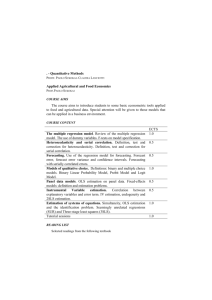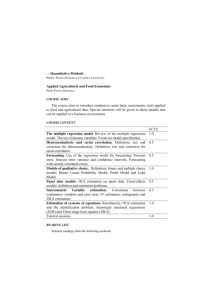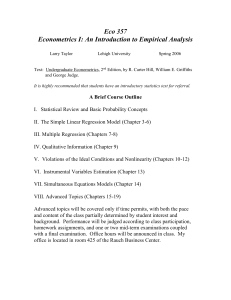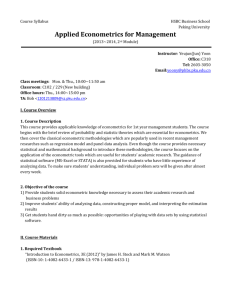Applied Econometrics - Faculty | Fordham
advertisement
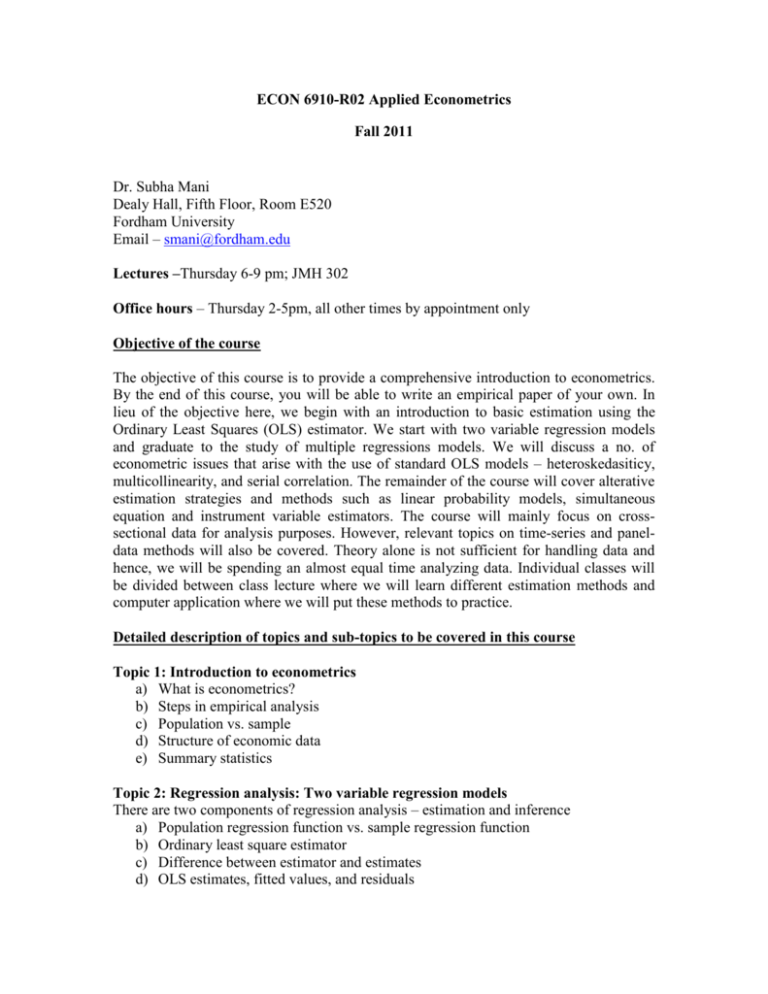
ECON 6910-R02 Applied Econometrics Fall 2011 Dr. Subha Mani Dealy Hall, Fifth Floor, Room E520 Fordham University Email – smani@fordham.edu Lectures –Thursday 6-9 pm; JMH 302 Office hours – Thursday 2-5pm, all other times by appointment only Objective of the course The objective of this course is to provide a comprehensive introduction to econometrics. By the end of this course, you will be able to write an empirical paper of your own. In lieu of the objective here, we begin with an introduction to basic estimation using the Ordinary Least Squares (OLS) estimator. We start with two variable regression models and graduate to the study of multiple regressions models. We will discuss a no. of econometric issues that arise with the use of standard OLS models – heteroskedasiticy, multicollinearity, and serial correlation. The remainder of the course will cover alterative estimation strategies and methods such as linear probability models, simultaneous equation and instrument variable estimators. The course will mainly focus on crosssectional data for analysis purposes. However, relevant topics on time-series and paneldata methods will also be covered. Theory alone is not sufficient for handling data and hence, we will be spending an almost equal time analyzing data. Individual classes will be divided between class lecture where we will learn different estimation methods and computer application where we will put these methods to practice. Detailed description of topics and sub-topics to be covered in this course Topic 1: Introduction to econometrics a) What is econometrics? b) Steps in empirical analysis c) Population vs. sample d) Structure of economic data e) Summary statistics Topic 2: Regression analysis: Two variable regression models There are two components of regression analysis – estimation and inference a) Population regression function vs. sample regression function b) Ordinary least square estimator c) Difference between estimator and estimates d) OLS estimates, fitted values, and residuals e) f) g) h) Interpretation of the OLS estimates Variance of OLS estimator Inference/hypothesis testing of single population parameter T test, confidence interval and p-values Topic 3: Multiple variable regression analysis a) Empirical specification b) OLS estimator c) Interpretation of OLS estimate, concept of ceteris paribus d) Variance of OLS estimator e) Omitted variables bias f) Misspecified models g) Hypothesis testing – t test, F test Topic 4: Multiple variable regression analysis: Further issues a) Functional form specifications b) Units of measurement c) Effects of data scaling d) Dummy variables Topic 5: Relaxing the assumptions of classical linear models a) Multicollinearity b) Heteroskedasticity c) Serial correlation Topic 6: Limited dependent variable a) Estimation – OLS, probit and logit b) Interpretation Topic 7: Instrument variable regression analysis and Simultaneous equation models a) IV estimation b) IV validity c) First-stage regression d) Simultaneity bias e) Identification and estimation Topic 8: Introduction to time-series and panel-data analysis a) Empirical specification b) Estimation and inference Textbook: Introductory Econometrics by Jeffrey M. Wooldridge, 4th or 5th edition The primary textbook provides you with an intuitive grasp of econometric problems. I also recommend Basic Econometrics by Damodar N. Gujarati, as a supplement. For students desiring more detailed mathematical proofs: George G. Judge et al, The Theory and Practice of Econometrics, (New York: Wiley), 1985. Class notes are very crucial for understanding of the course materials, since I will be using a combination of the above textbooks and from time to time other references too. Hence class participation is crucial, if you must miss a class, please let me know in advance, and be sure to obtain notes from a classmate. Computer Programs: We will be using SAS as our primary software to analyze data. SAS is installed on the computers in JMH, and on the economics department office computers. All computer programming will be covered in class. Students unfamiliar with computer programming or for those who may wish to purchase a supplementary text, I recommend: Delwiche, Lora, and Susan Slaughter, The Little SAS Book: A Primer. Third Edition. SAS Publishing: 2003 Course requirements: During this semester, you will have homework assignments, one midterm, final term paper, and class presentation. The final grade for the course will be calculated as a weighted average of the problem sets, midterm and the term paper; where the weights will be assigned as follows: Class participation and in class assignments – 15% Homework – 25% Midterm – 30% Term Paper and presentation– 30% Final Term Paper: The following is expected from your term paper - (1) It should identify a specific economic problem and focus on a well specified research question. (2) Research the topic of interest and include a brief review of the literature, not exceeding 2 pages. (3) Formulate an econometric specification, and determine what data you will need to collect to answer your research question. (3) Use or compile a data source to analyze the issue and to answer the question (identify the source in the text). (4) Empirically test your model using the estimation strategies taught in class (include all SAS programming code and results with your paper). (5) Test for estimation problems and make any necessary corrections. (6) Analyze your results. (7) Provide concluding remarks. The text of the paper should be no more than ten pages (double-spaced, 1-inch margin, 12-point font). Papers will be graded on correct application of econometric methods as well as correct grammar and spelling. Before the exam we will discuss the requirements for the paper in more detail and we will also discuss possible data sources. I will recommend some research papers that can be used as guidelines for what is expected from the term paper. Also read chapter 19 – Carrying out an Empirical Project from Wooldridge. This chapter provides an excellent review of what a student should do to make a good empirical paper. Students should have a paper topic by 31st October. By this date, each student should have come to me during office hours to discuss their topic and let me know of the data source they have picked. A printed version of your final paper and all relevant SAS code and results are due in my office by 4 pm on Thursday, 15th December. Important points to note 1) Make-up Exam: Examinations are to be taken at the time indicated in class. A makeup examination may be given only in the instance where you have notified me and the Dean’s office of the reason for your absence prior to the examination. 2) Homework: You can leave your homeworks in my mailbox. It is your responsibility to make sure that I received your homework, email me to make sure I got your homework. Please type your answers and hand in a copy of your answers and all results (including SAS code). I will not accept homework answers, results, or SAS code via email. Any homework received after due date will be marked as late and Late homeworks receive zero points, no exceptions. 3) Disabilities: Under the Americans with Disabilities Act and Section 504 of the Vocational and Rehabilitation Act of 1973, all students, with or without disabilities are entitled to equal access to the programs and activities at Fordham University. If you believe that you have a disabling condition that may interfere with your ability to participate in the activities, coursework, or assessment of the object of this course, you may be entitled to accommodations. Please schedule an appointment to speak with someone at the Office of Disability Services (Rose Hill - O’ Hare Hall, Lower Level, 718-817-0655 or at Lincoln Center – Room 207, 718-817-6282). Also kindly come to me immediately and inform me of any disabling condition. Course schedule: Week 1: Topic 1: Introduction to econometrics Week 2: Topic 2: Two variable regression analysis – OLS estimation Week 3: Topic 2: Two variable regression analysis – inference First Homework Week 4: Topic 3: Multiple regression analysis – Estimation Week 5: Topic 3: Multiple regression analysis – Inference Second Homework Week 6: Topic 4: Multiple regression analysis – Further issues Week 7: Topic 4: Multiple regression analysis – Further issues Week 8: Topic 5: Multicollinearity and review for midterm Third Homework Week 9: Midterm – 27th October 2011 Week 10: Topic 5: Heteroskedasticity and Serial correlation Week 11: Topic 6: Advanced topics in linear regression analysis Week 12: Topic 7: Limited dependent variable – estimation and inference Fourth Homework Week 13: Topic 8: Instrumental variable estimator and Simultaneous equation models Week 14: 8th December - In class presentations The best presenter will receive a prize, let’s make this competitive! Due date for the final term paper is 15th December, by 4 pm. All term papers should be emailed to me at smani@fordham.edu including the complete SAS code used for analysis purposes. A hardcopy of the term paper must also be submitted by the due date.




